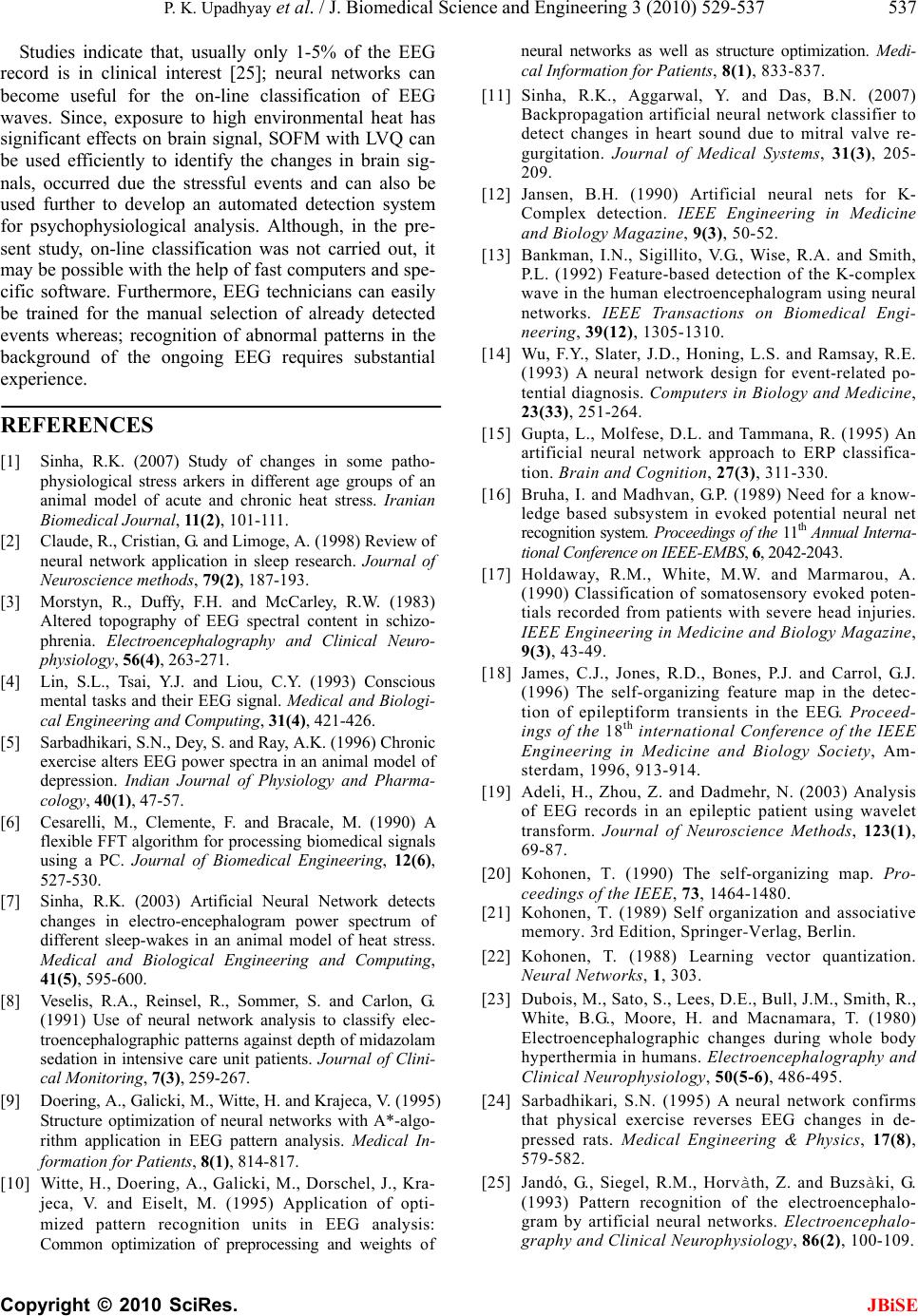
P. K. Upadhyay et al. / J. Biomedical Science and Engineering 3 (2010) 529-537 537
Copyright © 2010 SciRes.
Studies indicate that, usually only 1-5% of the EEG
record is in clinical interest [25]; neural networks can
become useful for the on-line classification of EEG
waves. Since, exposure to high environmental heat has
significant effects on brain signal, SOFM with LVQ can
be used efficiently to identify the changes in brain sig-
nals, occurred due the stressful events and can also be
used further to develop an automated detection system
for psychophysiological analysis. Although, in the pre-
sent study, on-line classification was not carried out, it
may be possible with the help of fast computers and spe-
cific software. Furthermore, EEG technicians can easily
be trained for the manual selection of already detected
events whereas; recognition of abnormal patterns in the
background of the ongoing EEG requires substantial
experience.
JBiSE
REFERENCES
[1] Sinha, R.K. (2007) Study of changes in some patho-
physiological stress arkers in different age groups of an
animal model of acute and chronic heat stress. Iranian
Biomedical Journal, 11(2), 101-111.
[2] Claude, R., Cristian, G. and Limoge, A. (1998) Review of
neural network application in sleep research. Journal of
Neuroscience methods, 79(2), 187-193.
[3] Morstyn, R., Duffy, F.H. and McCarley, R.W. (1983)
Altered topography of EEG spectral content in schizo-
phrenia. Electroencephalography and Clinical Neuro-
physiology, 56(4), 263-271.
[4] Lin, S.L., Tsai, Y.J. and Liou, C.Y. (1993) Conscious
mental tasks and their EEG signal. Medical and Biologi-
cal Engineering and Computing, 31(4), 421-426.
[5] Sarbadhikari, S.N., Dey, S. and Ray, A.K. (1996) Chronic
exercise alters EEG power spectra in an animal model of
depression. Indian Journal of Physiology and Pharma-
cology, 40(1), 47-57.
[6] Cesarelli, M., Clemente, F. and Bracale, M. (1990) A
flexible FFT algorithm for processing biomedical signals
using a PC. Journal of Biomedical Engineering, 12(6),
527-530.
[7] Sinha, R.K. (2003) Artificial Neural Network detects
changes in electro-encephalogram power spectrum of
different sleep-wakes in an animal model of heat stress.
Medical and Biological Engineering and Computing,
41(5), 595-600.
[8] Veselis, R.A., Reinsel, R., Sommer, S. and Carlon, G.
(1991) Use of neural network analysis to classify elec-
troencephalographic patterns against depth of midazolam
sedation in intensive care unit patients. Journal of Clini-
cal Monitoring, 7(3), 259-267.
[9] Doering, A., Galicki, M., Witte, H. and Krajeca, V. (1995)
Structure optimization of neural networks with A*-algo-
rithm application in EEG pattern analysis. Medical In-
formation for Patients, 8(1), 814-817.
[10] Witte, H., Doering, A., Galicki, M., Dorschel, J., Kra-
jeca, V. and Eiselt, M. (1995) Application of opti-
mized pattern recognition units in EEG analysis:
Common optimization of preprocessing and weights of
neural networks as well as structure optimization. Medi-
cal Information for Patients, 8(1), 833-837.
[11] Sinha, R.K., Aggarwal, Y. and Das, B.N. (2007)
Backpropagation artificial neural network classifier to
detect changes in heart sound due to mitral valve re-
gurgitation. Journal of Medical Systems, 31(3), 205-
209.
[12] Jansen, B.H. (1990) Artificial neural nets for K-
Complex detection. IEEE Engineering in Medicine
and Biology Magazine, 9(3), 50-52.
[13] Bankman, I.N., Sigillito, V.G., Wise, R.A. and Smith,
P.L. (1992) Feature-based detection of the K-complex
wave in the human electroencephalogram using neural
networks. IEEE Transactions on Biomedical Engi-
neering, 39(12), 1305-1310.
[14] Wu, F.Y., Slater, J.D., Honing, L.S. and Ramsay, R.E.
(1993) A neural network design for event-related po-
tential diagnosis. Computers in Biology and Medicine,
23(33), 251-264.
[15] Gupta, L., Molfese, D.L. and Tammana, R. (1995) An
artificial neural network approach to ERP classifica-
tion. Brain and Cognition, 27(3), 311-330.
[16] Bruha, I. and Madhvan, G.P. (1989) Need for a know-
ledge based subsystem in evoked potential neural net
recognition system. Proceedings of the 11 th Annual Interna-
tional Conference on IEEE-EMBS, 6, 2042-2043.
[17] Holdaway, R.M., White, M.W. and Marmarou, A.
(1990) Classification of somatosensory evoked poten-
tials recorded from patients with severe head injuries.
IEEE Engineering in Medicine and Biology Magazine,
9(3), 43-49.
[18] James, C.J., Jones, R.D., Bones, P.J. and Carrol, G.J.
(1996) The self-organizing feature map in the detec-
tion of epileptiform transients in the EEG. Proceed-
ings of the 18th international Conference of the IEEE
Engineering in Medicine and Biology Society, Am-
sterdam, 1996, 913-914.
[19] Adeli, H., Zhou, Z. and Dadmehr, N. (2003) Analysis
of EEG records in an epileptic patient using wavelet
transform. Journal of Neuroscience Methods, 123(1),
69-87.
[20] Kohonen, T. (1990) The self-organizing map. Pro-
ceedings of the IEEE, 73, 1464-1480.
[21] Kohonen, T. (1989) Self organization and associative
memory. 3rd Edition, Springer-Verlag, Berlin.
[22] Kohonen, T. (1988) Learning vector quantization.
Neural Networks, 1, 303.
[23] Dubois, M., Sato, S., Lees, D.E., Bull, J.M., Smith, R.,
White, B.G., Moore, H. and Macnamara, T. (1980)
Electroencephalographic changes during whole body
hyperthermia in humans. Electroencephalography and
Clinical Neurophysiology, 50(5-6), 486-495.
[24] Sarbadhikari, S.N. (1995) A neural network confirms
that physical exercise reverses EEG changes in de-
pressed rats. Medical Engineering & Physics, 17(8),
579-582.
[25] Jandó, G., Siegel, R.M., Horvàth, Z. and Buzsàki, G.
(1993) Pattern recognition of the electroencephalo-
gram by artificial neural networks. Electroencephalo-
graphy and Clinical Neurophysiology, 86(2), 100-109.